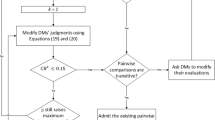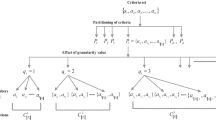Abstract
In group decision-making (GDM) model, experts often evaluate their opinion by using triangular fuzzy numbers. The preference relations with triangular fuzzy numbers are in consistent in nature, so we turned to neutrosophic in this paper. It is very important to take into account consistency of expert opinion and consensus degree in GDM. In order to distinguish the typical consistency, the concept of additive approximation consistency is proposed for triangular neutrosophic additive reciprocal matrices. The properties of triangular neutrosophic additive reciprocal matrices with additive approximation consistency are studied in detail. Second, by using \((n-1)\) restricted preference values, a triangular neutrosophic additive reciprocal preference relation with additive approximation consistency is constructed. The differences among expert’s opinions are measured using consensus degree. For generating a collective triangular neutrosophic additive reciprocal matrix with additive approximation consistency, the neutrosophic triangular weighted aggregation operator is used. Finally, a novel algorithm for the group decision-making problem with triangular neutrosophic additive reciprocal preference relations is presented. A numerical example is carried out to illustrate the proposed definitions and algorithm.



Similar content being viewed by others
References
Atanassov KT (1986) Intuitionistic fuzzy sets. Fuzzy Sets Syst 20(1):87–96
Benítez J, Delgado-Galván X, Izquierdo J, Pérez-García R (2012) Improving consistency in AHP decision-making processes. Appl Math Comput 219(2):2432–2441
Büyüközkan G, Çifçi G (2012) A new incomplete preference relations based approach to quality function deployment. Inf Sci 206:30–41
Cabrerizo FJ, Pérez IJ, Herrera-Viedma E (2010) Managing the consensus in group decision making in an unbalanced fuzzy linguistic context with incomplete information. Knowl-Based Syst 23(2):169–181
Chiclana F, Herrera F, Herrera-Viedma E (2001) Integrating multiplicative preference relations in a multipurpose decision-making model based on fuzzy preference relations. Fuzzy Sets Syst 122(2):277–291
Dubois D (2011) The role of fuzzy sets in decision sciences: old techniques and new directions. Fuzzy Sets Syst 184(1):3–28
Fan ZP, Ma J, Jiang YP, Sun YH, Ma L (2006) A goal programming approach to group decision making based on multiplicative preference relations and fuzzy preference relations. Eur J Oper Res 174(1):311–321
Gong ZW (2008) Least-square method to priority of the fuzzy preference relations with incomplete information. Int J Approx Reason 47(2):258–264
Herrera-Viedma E, Herrera F, Chiclana F, Luque M (2004) Some issues on consistency of fuzzy preference relations. Eur J Oper Res 154(1):98–109
Herrera-Viedma E, Chiclana F, Herrera F, Alonso S (2007) Group decision-making model with incomplete fuzzy preference relations based on additive consistency. IEEE Trans Syst Man Cybern B (Cybern) 37(1):176–189
Jiang Y, Xu Z, Gao M (2015) Methods for ranking intuitionistic multiplicative numbers by distance measures in decision making. Comput Ind Eng 88:100–109
Kaufmann A, Gupta MM (1988) Fuzzy mathematical models in engineering and management science. Elsevier Science Inc., Amsterdam
Liao H, Xu Z, Zeng XJ, Merigó JM (2015) Framework of group decision making with intuitionistic fuzzy preference information. IEEE Trans Fuzzy Syst 23(1):1211–1227
Liao H, Xu Z, Zeng XJ, Xu DL (2016) An enhanced consensus reaching process in group decision making with intuitionistic fuzzy preference relations. Inf Sci 329:274–286
Liu F (2009) Acceptable consistency analysis of interval reciprocal comparison matrices. Fuzzy Sets Syst 160(18):2686–2700
Liu P, Wang Y (2014) Multiple attribute decision-making method based on single-valued neutrosophic normalized weighted Bonferroni mean. Neural Comput Appl 25(7–8):2001–2010
Liu F, Zhang WG, Wang ZX (2012) A goal programming model for incomplete interval multiplicative preference relations and its application in group decision-making. Eur J Oper Res 218(3):747–754
Liu F, Zhang WG, Fu JH (2012) A new method of obtaining the priority weights from an interval fuzzy preference relation. Inf Sci 185(1):32–42
Liu F, Zhang WG, Zhang LH (2014) Consistency analysis of triangular fuzzy reciprocal preference relations. Eur J Oper Res 235(3):718–726
Liu F, Pedrycz W, Zhang WG (2016) Limited rationality and its quantification through the interval number judgments with permutations. IEEE Trans Cybern 99:1–13
Meng F, Chen X, Zhang Y (2016) Consistency-based linear programming models for generating the priority vector from interval fuzzy preference relations. Appl Soft Comput 41:247–264
Meng F, Tan C, Chen X (2017) Multiplicative consistency analysis for interval fuzzy preference relations: A comparative study. Omega 68:17–38
Meng F, Lin J, Tan C, Zhang Q (2017) A new multiplicative consistency based method for decision making with triangular fuzzy reciprocal preference relations. Fuzzy Sets Syst 315:1–25
Pedrycz W, Song M (2011) Analytic hierarchy process (AHP) in group decision making and its optimization with an allocation of information granularity. IEEE Trans Fuzzy Syst 19(3):527–539
Peneva V, Popchev I (2007) Aggregation of fuzzy preference relations to multicriteria decision making. Fuzzy Optim Decis Mak 6(1):351–365
Saaty TL (2008) Decision making with the analytic hierarchy process. Int J Serv Sci 1(1):83–98
Saaty TL, Vargas LG (1987) Uncertainty and rank order in the analytic hierarchy process. Eur J Oper Res 32(1):107–117
Samuel OW, Asogbon GM, Sangaiah AK, Fang P, Li G (2017) An integrated decision support system based on ANN and Fuzzy_ AHP for heart failure risk prediction. Expert Syst Appl 68:163–172
Sangaiah A, Thangavelu A (2013) An exploration of FMCDM approach for evaluating the outcome/success of GSD projects. Open Eng 3(3):419–435
Sangaiah AK, Gopal J, Basu A, Subramaniam PR (2017) An integrated fuzzy DEMATEL, TOPSIS, and ELECTRE approach for evaluating knowledge transfer effectiveness with reference to GSD project outcome. Neural Comput Appl 28(1):111–123
Smarandache F (2004) A geometric interpretation of the neutrosophic set—a generalization of the intuitionistic fuzzy set. arXiv preprint arXiv:math/0404520
Smarandache F (2005) A unifying field in logics: neutrosophic logic. neutrsophic logic. neutrosophy, neutrosophic set, neutrosophic probability. infinite study, neutrosophy, neutrosophic set, neutrosophic probability, American Research Press. ISBN 978-1-59973-080-6
Tanino T (1984) Fuzzy preference orderings in group decision making. Fuzzy Sets Syst 12(2):117–131
Urena R, Chiclana F, Fujita H, Herrera-Viedma E (2015) Confidence-consistency driven group decision making approach with incomplete reciprocal intuitionistic preference relations. Knowl-Based Syst 89:86–96
Wang ZJ (2015) Consistency analysis and priority derivation of triangular fuzzy preference relations based on modal value and geometric mean. Inf Sci 314:169–183
Wang TC, Chen YH (2007) Applying consistent fuzzy preference relations to partnership selection. Omega 35(1):384–388
Wang TC, Chen YH (2008) Applying fuzzy linguistic preference relations to the improvement of consistency of fuzzy AHP. Inf Sci 178(19):3755–3765
Wang ZJ, Tong X (2016) Consistency analysis and group decision making based on triangular fuzzy additive reciprocal preference relations. Inf Sci 361:29–47
Wang YM, Yang JB, Xu DL (2005) Interval weight generation approaches based on consistency test and interval comparison matrices. Appl Math Comput 167(1):252–273
Wu Z, Xu J (2012) A consistency and consensus based decision support model for group decision making with multiplicative preference relations. Decis Support Syst 52(3):757–767
Xu Z (2007) Intuitionistic fuzzy aggregation operators. IEEE Trans Fuzzy Syst 15(3):1179–1187
Xu Z, Chen J (2008) Group decision-making procedure based on incomplete reciprocal relations. Soft Comput A Fus Found Methodol Appl 12(3):515–521
Xu Z, Chen J (2008) Some models for deriving the priority weights from interval fuzzy preference relations. Eur J Oper Res 184(1):266–280
Zadeh LA (1965) Fuzzy sets. Inf Control 8(3):338–353
Acknowledgements
We all want to thank anonymous for the constructive suggestions that improved both the quality and clarity of the research.
Author information
Authors and Affiliations
Corresponding author
Ethics declarations
Conflicts of interest
The authors declare that there is no conflict of interests regarding the publication of this article.
Human and animal rights
This article does not contain any studies with human participants or animals performed by any of the authors.
Informed consent
Informed consent was obtained from all individual participants included in the study.
Additional information
Communicated by G. Yi.
Rights and permissions
About this article
Cite this article
Abdel-Basset, M., Mohamed, M., Hussien, AN. et al. A novel group decision-making model based on triangular neutrosophic numbers. Soft Comput 22, 6629–6643 (2018). https://doi.org/10.1007/s00500-017-2758-5
Published:
Issue Date:
DOI: https://doi.org/10.1007/s00500-017-2758-5




